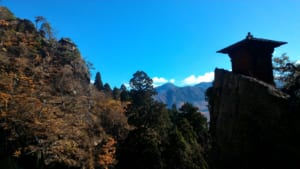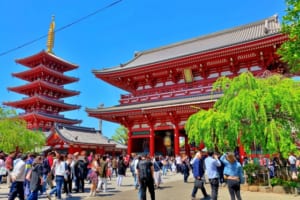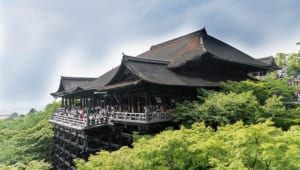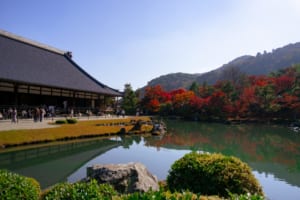15 Best Temples in Japan
Divine Sanctuaries: 15 Must-Visit Temples in Japan

Buddhism, alongside Shintoism, is a major aspect that shapes the beautiful culture of Japan that many people around the world have fallen in love with. What better way to get in touch with this part of Japanese culture than to go visit some of these incalculably valuable places that are situated across the country?
Japanese Buddhist temples are quite different from those in India, China, and even South Korea, providing a unique experience even if you’ve visited temples from these other countries.
Join us as we introduce to you our list of the 15 best temples in Japan and explore these hallowed grounds, immersing ourselves in the rich tapestry of Japan’s ancient traditions and sacred wonders. From the bustling streets of Tokyo to the tranquil countryside of Kyoto and beyond, each temple unveils a unique blend of cultural heritage, architectural marvels, and spiritual significance.
Buddhism in Japan
Buddhism in Japan is a profound and influential religious tradition that has deeply shaped the country’s history and cultural identity. Introduced in the 6th century, Buddhism arrived from China and Korea, gradually integrating with indigenous beliefs.
It encompasses a diverse range of Buddhist schools, including Zen, Pure Land, and Nichiren. Buddhism in Japan combines teachings on enlightenment, compassion, and the cycle of rebirth. It has played a crucial role in shaping Japanese arts, philosophy, and societal values, promoting harmony, mindfulness, and the pursuit of inner peace.
Today, Buddhism continues to be a significant spiritual force, with temples and rituals serving as cherished cultural and historical landmarks.
Features of Buddhist Temples
Buddhist temples in Japan possess distinct features that make them intriguing to foreign travelers.
Architecturally, they showcase unique designs with intricate wooden structures, ornate roofs, and exquisite craftsmanship. Unlike some temples in other countries, Japanese temples often blend seamlessly with nature, offering serene gardens and picturesque landscapes. Visitors can witness stunning Buddha statues, ancient relics, and engaging ritual practices.
Japanese temples also stand out for their cultural significance, reflecting Japan’s rich spiritual heritage. People should visit Japanese temples to experience the peaceful and meditative atmosphere, immerse themselves in Japanese culture, and gain insights into the profound philosophy of Buddhism while enjoying the beauty of the temple surroundings.
Tohoku
1. Hiraizumi Chusonji Temple (Iwate)

The main hall, Konjikido, is a remarkable golden structure adorned with intricate details. It houses valuable Buddhist relics and treasures, providing a glimpse into Japan’s ancient past. Chusonji Temple’s popularity stems from its preservation of Japan’s medieval history and its ability to transport visitors to a bygone era.
 Access Access |
10 minute bus ride from Hiraizumi Station (JR Tohoku Line) |
|---|---|
 Official Website Official Website |
https://www.chusonji.or.jp/language_en/index.html |
2. Yamadera Temple (Yamagata)
Risshakuji Temple (宝珠山立石寺), more commonly known as Yamadera Temple (山寺), is a captivating destination that lures international travelers seeking spiritual enlightenment and natural beauty. Located in Yamagata prefecture, this centuries-old Buddhist temple is perched atop a mountainside, offering breathtaking panoramic views of the surrounding valleys and forests.
Visitors ascend a steep stone staircase, passing through lush greenery and cascading waterfalls, to reach the temple’s main hall. The tranquil atmosphere, awe-inspiring scenery, and the temple’s deep historical roots make it a popular choice among international visitors.
 Access Access |
5 minute walk from Yamadera Station (JR Senzan Line) |
|---|---|
 Official Website Official Website |
https://www.rissyakuji.jp/ |
For more information about this temple, check out the following article.
Tokyo and Kanto
3. Sensoji Temple (Tokyo)

Upon entering through the majestic Kaminarimon Gate, visitors are greeted by Nakamise, a bustling shopping street brimming with traditional souvenirs and delectable snacks. The temple’s main hall, dedicated to the Bodhisattva Kannon, is a sight to behold with its intricate architecture and spiritual ambiance. Sensoji Temple’s popularity among international visitors lies in its ability to provide an authentic Japanese cultural experience, combining spirituality, traditional craftsmanship, and the charm of old-world Tokyo.
 Access Access |
2 minute walk from Asakusa Station (Tokyo Metro Lines) |
|---|---|
 Official Website Official Website |
https://www.senso-ji.jp/english/ |
For more information about this temple, check out the following articles.
4. Zojoji Temple (Tokyo)

The temple’s striking entrance gate, Sangedatsumon, and the impressive main hall, Daiden, leave visitors in awe of their grandeur and architectural beauty. Zojoji Temple is also famous for its stunning view of the Tokyo Tower, creating a picturesque backdrop for memorable photos.
 Access Access |
7 minute walk from Daimon Station (Asakusa Line, Oedo Line) |
|---|---|
 Official Website Official Website |
https://www.zojoji.or.jp/en/ |
For more information about this temple, check out the following article.
5. Gotokuji Temple (Tokyo)

This historic Buddhist temple is renowned for its association with Maneki-neko, the beckoning cat figurine believed to bring luck and prosperity. The temple grounds are adorned with countless ceramic cat statues, creating a whimsical and enchanting atmosphere. Visitors can explore the serene gardens and pay their respects at the main hall, which houses sacred relics.
 Access Access |
5 minute walk from Miyanosaka Station (Tokyu Setagaya line) |
|---|---|
 Official Website Official Website |
https://gotokuji.jp/en/ |
For more information about this temple, check out the following article.
6. Hasedera Temple (Kanagawa)

Its main attraction is the towering wooden statue of Kannon, the Goddess of Mercy, which stands at an impressive height of 9.18 meters. The temple’s lush gardens, adorned with vibrant flowers and serene ponds, provide a peaceful retreat for contemplation and reflection.
 Access Access |
5 minute walk from Hase Station (Enoden Line) |
|---|---|
 Official Website Official Website |
https://www.hasedera.jp/en/ |
7. Naritasan Shinshoji Temple (Chiba)

The highlight is the Main Hall, housing a magnificent statue of Fudo Myoo, a revered Buddhist deity. Since it is located in Narita, this can be potentially the first (or last) temple you visit in Japan. Either way, it is located in a very accessible place.
 Access Access |
15 minute walk from Narita Station (JR Lines) |
|---|---|
 Official Website Official Website |
https://www.naritasan.or.jp/english/ |
For more information about this temple, check out the following article.
Central Japan
8. Zenkoji Temple (Nagano)

The temple’s main hall, although hidden from view, offers a profound spiritual experience to visitors who partake in the symbolic journey of touching the “Key to Paradise.” The roof of the main hall was just repaired in 2022, so you will be seeing the new version of this majestic historical building.
 Access Access |
13 minute walk from Zenkojishita Station (Nagano Dentetsu Line) |
|---|---|
 Official Website Official Website |
https://www.zenkoji.jp/en/ |
9. Daihonzan Eiheiji Temple (Fukui)

Eiheiji Temple’s austere yet picturesque surroundings, with its tranquil gardens and traditional architecture, provide an authentic experience of Zen practice. It offers a truly transformative and enriching experience for spiritual seekers.
 Access Access |
13 minute bus ride from Eiheijiguchi Station (Echizentetsudo-Katsuyama-Eiheiji Line) |
|---|---|
 Official Website Official Website |
https://daihonzan-eiheiji.com/en/ |
Kyoto and Western Japan
10. Kiyomizudera Temple (Kyoto)

Perched on a hillside, the temple offers stunning panoramic views of the surrounding city and cherry blossom-filled gardens. Its main hall, supported by wooden pillars, stands without the use of nails, a marvel of traditional architecture. Kiyomizudera Temple is renowned for its Otawa Waterfall, where visitors can drink from three streams believed to grant health, longevity, and success in studies. International visitors flock to this temple for its picturesque setting, cultural heritage, and the enchanting experience of walking the famous wooden terrace, offering a sense of spiritual serenity and connection to Japan’s rich history.
 Access Access |
20 minute walk from Kiyomizu-Gojo Station (Keihan Main Line) |
|---|---|
 Official Website Official Website |
https://www.kiyomizudera.or.jp/en/ |
For more information about this temple, check out the following article.
11. Kinkakuji Temple (Kyoto)
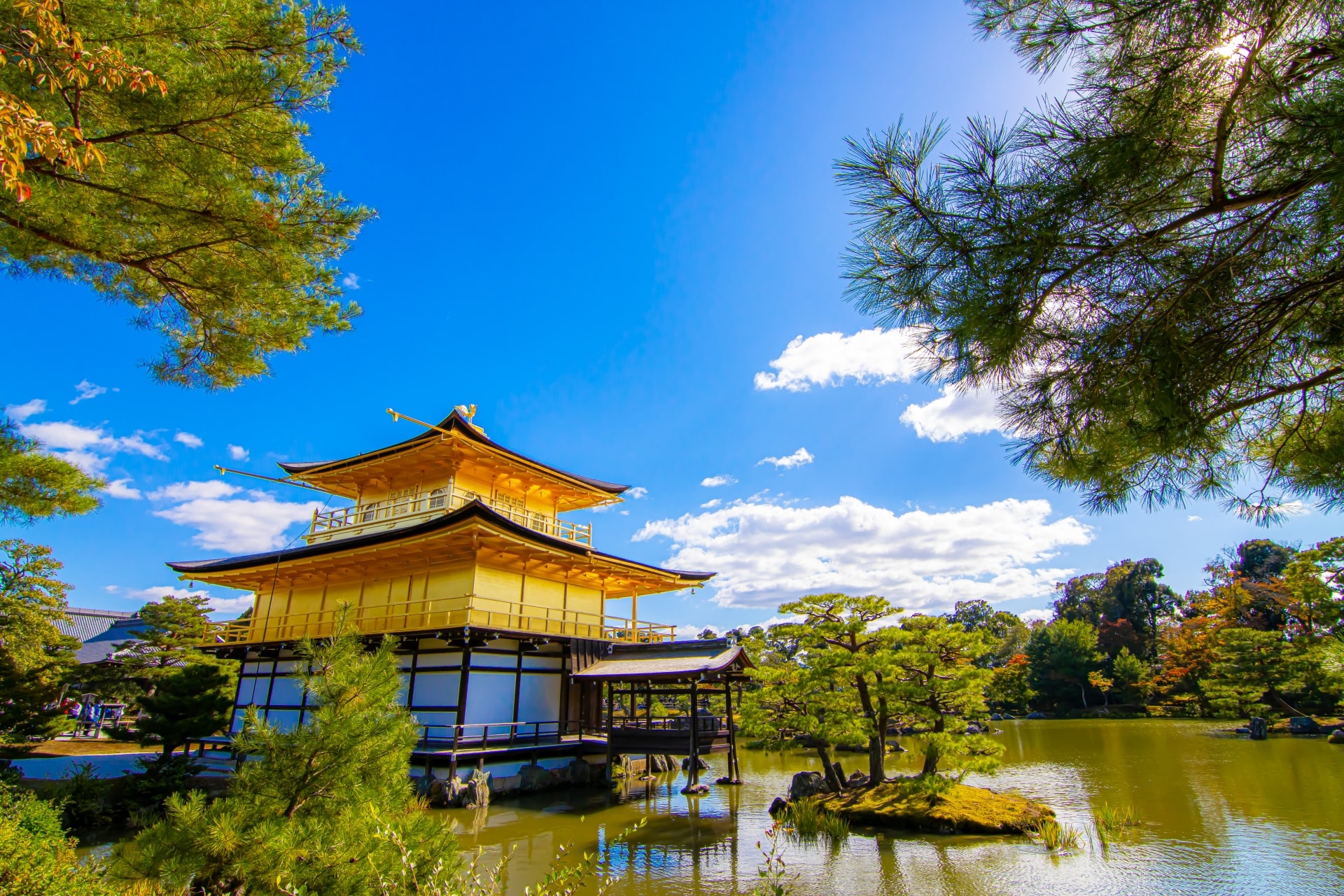
The top two floors of the temple are adorned with gold leaf, shimmering beautifully against the backdrop of a tranquil pond and meticulously manicured gardens. Kinkakuji Temple’s popularity among international visitors lies in its striking beauty, symbolizing harmony between nature and human creation.
 Access Access |
30 minute bus ride from Kyoto Station to "Kinkakuji-michi Stop", then take a 5 minute walk. |
|---|---|
 Official Website Official Website |
https://www.shokoku-ji.jp/en/kinkakuji/ |
For more information about this temple, check out the following article.
12. Tenryuji Temple (Kyoto)

As a UNESCO World Heritage site, it boasts a stunning garden that perfectly embodies the concept of “borrowed scenery,” seamlessly integrating with the Arashiyama Bamboo Grove. The temple’s main hall, a designated national treasure, offers a glimpse into Japan’s architectural elegance.
 Access Access |
5 minute walk from Arashiyama Station (Randen) |
|---|---|
 Official Website Official Website |
https://www.tenryuji.com/en/ |
For more information about this temple, check out the following article.
13. Todaiji Temple (Nara)

Stepping inside, visitors are immersed in a sense of wonder as they encounter the towering figure. Todaiji Temple’s popularity among international visitors lies in its historical importance, magnificent craftsmanship, and the opportunity to witness the spiritual and artistic achievements of ancient Japan. The temple’s serene park setting, which is also home to friendly roaming deer, adds to its appeal, creating an unforgettable experience of Japan’s cultural heritage.
 Access Access |
13 minute walk from Kintetsu-Nara Station (Kintetsu Lines) |
|---|---|
 Official Website Official Website |
https://www.todaiji.or.jp/en/ |
For more information about this temple, check out the following article.
14. Nachisan Seigantoji Temple (Wakayama)

The temple’s elegant pagoda (Sanjuto Pagoda) adds to the picturesque landscape. It provides a serene retreat where travelers can experience the harmony between Buddhism and nature, immersing themselves in the tranquility and magnificence of Japan’s spiritual traditions.
 Access Access |
20-30 minute bus ride from Kii-Katsruura Station |
|---|---|
 Official Website Official Website |
https://nachikan.jp/en/spot/2311/ |
For more information about the Nachi Falls right next to the temple, check out the following article.
Kyushu
15. Nanzoin Temple (Fukuoka)

Nanzoin Temple’s popularity among visitors lies in its unique cultural and spiritual significance. It offers a peaceful sanctuary where visitors can admire the majestic statue, explore the temple grounds, and experience a sense of tranquility and reverence.
 Access Access |
3 minutes walk from Kido Nanzoinmae Station (JR Fukuhoku Yutaka Line) |
|---|---|
 Official Website Official Website |
https://nanzoin.net/en/ |
For more information about Temples, Shrines, and Japanese culture, be sure to check the articles below.
Written by
Born and raised in Costa Rica, I started living in Tokyo from college. I love traveling within Japan & around the world. Since I wasn’t born in Japan, I know the cultural impact that you can get when visiting Japan for the first time and what you might be worried about before your trip. And I’ve lived long enough to somewhat understand the nuances of the Japanese culture that make this country such an attractive place to visit. Hopefully I can provide to you both the information you’re looking for and the information you didn’t know you needed to know.






